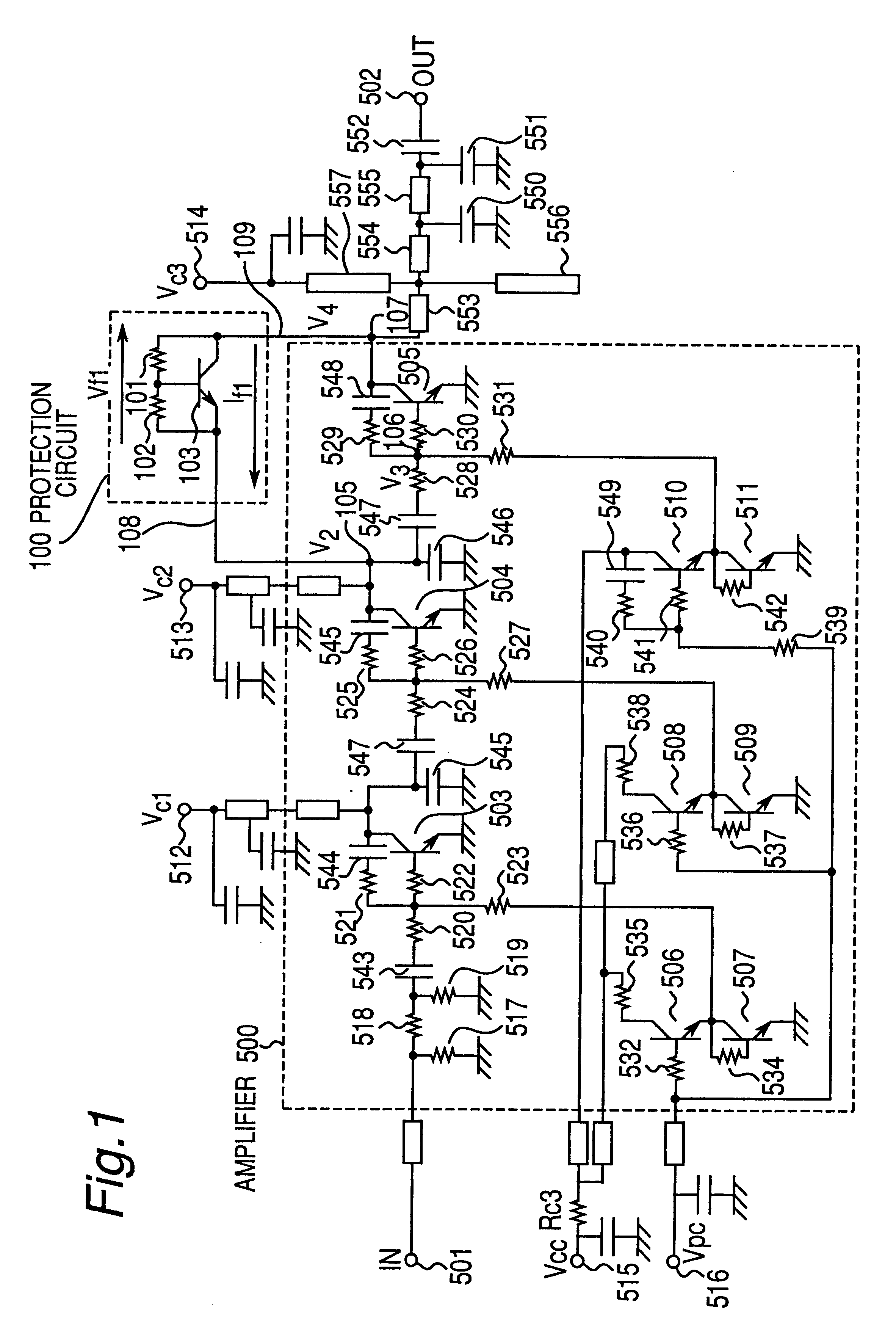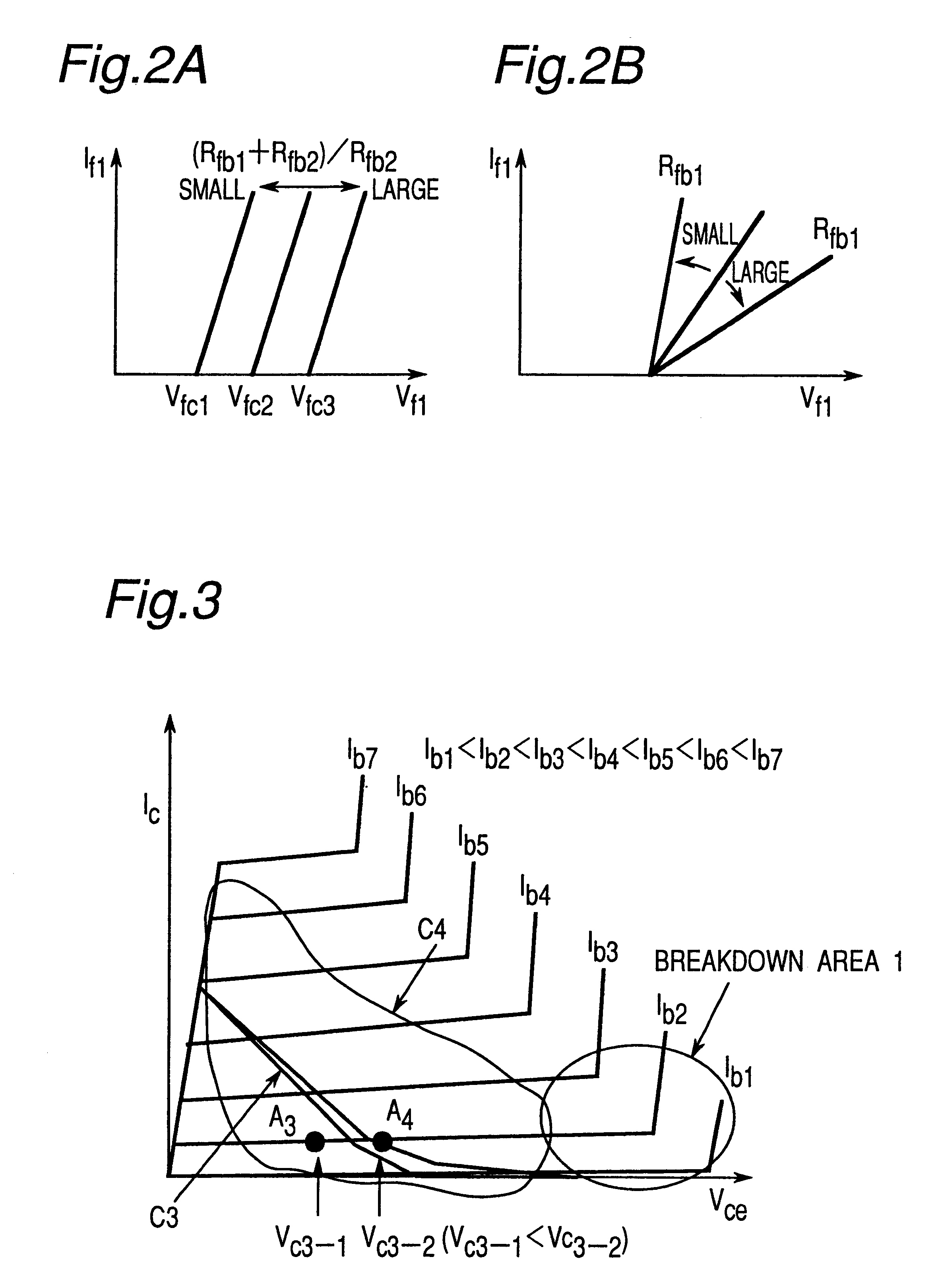Power amplifier
a power amplifier and power supply technology, applied in the direction of amplifier combinations, single-ended push-pull amplifiers, gain control, etc., can solve the problems of large-scale cut-off circuits and regulators, high power consumption devices, and inability to dispose of cut-off circuits or regulators
- Summary
- Abstract
- Description
- Claims
- Application Information
AI Technical Summary
Problems solved by technology
Method used
Image
Examples
embodiment 2
FIG. 4 is a circuit diagram of a protection circuit 130 according to a second preferred embodiment of the present invention used in the above-described power amplifier 500. Note that FIG. 4 shows only the significant circuit elements in the area of the second and third stage transistors 504 and 505 in power amplifier 500.
This protection circuit 130 comprises five transistors 131 to 135 diode connected in series with the collector of each transistor shorted to the base. The collector of transistor 131 is connected to terminal 137. This terminal 137 is connected to node 107 of power amplifier 500. The emitter of transistor 131-is connected to the collector of transistor 132. The emitter of transistor 132 is connected to the collector of transistor 133. The emitter of transistor 133 is connected to the collector of transistor 134. The emitter of transistor 134 is connected to the collector of transistor 135. The emitter of transistor 135 is connected to terminal 136, and terminal 136 i...
embodiment 3
FIG. 5 is a circuit diagram of a protection circuit 140 according to a third preferred embodiment of the present invention used in the above-described power amplifier 500. Note that FIG. 5 shows only the significant circuit elements in the area of the second and third stage transistors 504 and 505 in power amplifier 500.
As will be known from FIG. 5, this protection circuit 140 is substantially protection circuit 100 according to the first embodiment, further comprising a resistor 141 connected to the collector of transistor 103. Note that like parts in protection circuit 100 and this protection circuit 140 are identified by like reference numerals.
The on voltage of the protection circuit 140 thus comprised is (R.sub.fb1 +R.sub.fb2) / R.sub.fb2.times.1.3 (V). The on resistance can be adjusted by controlling resistance R.sub.fb1 of resistor 101 and R.sub.fc1 of resistor 141. It is therefore possible to more precisely control the feedback current. Other effects and achievements of this e...
embodiment 4
FIG. 6 is a circuit diagram of a protection circuit 150 according to a fourth preferred embodiment of the present invention used in the above-described power amplifier 500. Note that FIG. 6 shows only the significant circuit elements in the area of the second and third stage transistors 504 and 505 in power amplifier 500.
As will be known from FIG. 6, this protection circuit 150 is substantially protection circuit 100 according to the first embodiment, further comprising a resistor 151 connected to the emitter of transistor 103. Note that like parts in protection circuit 100 and this protection circuit 150 are identified by like reference numerals.
The on voltage of a protection circuit 150 thus comprised is (R.sub.fb1 +R.sub.fb2) / R.sub.fb2.times.1.3 (V). As with a protection circuit 140 according to the above third embodiment of the invention, the on resistance of this protection circuit 150 can be adjusted by controlling resistance R.sub.fb1 of resistor 101 and R.sub.fe1 of resistor...
PUM
 Login to View More
Login to View More Abstract
Description
Claims
Application Information
 Login to View More
Login to View More - R&D
- Intellectual Property
- Life Sciences
- Materials
- Tech Scout
- Unparalleled Data Quality
- Higher Quality Content
- 60% Fewer Hallucinations
Browse by: Latest US Patents, China's latest patents, Technical Efficacy Thesaurus, Application Domain, Technology Topic, Popular Technical Reports.
© 2025 PatSnap. All rights reserved.Legal|Privacy policy|Modern Slavery Act Transparency Statement|Sitemap|About US| Contact US: help@patsnap.com



